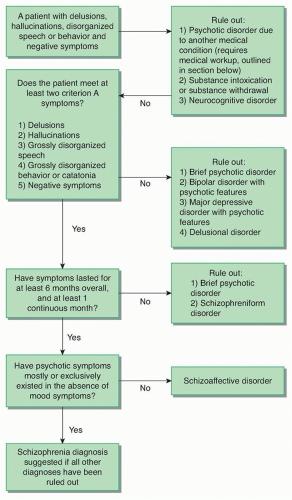INTRODUCTION
Psychosis is characterized as a detachment from reality, often including hallucinations or delusions. Psychotic symptoms are a core feature of schizophrenia but may also be seen in other serious psychiatric disorders including bipolar disorder, major depressive disorder, and posttraumatic stress disorder (PTSD). Importantly, psychosis may also be a prominent symptom in many neurologic disorders, other medical conditions, substance intoxications, and withdrawal syndromes. New-onset psychosis should prompt a thorough workup to determine the etiology of such symptoms.
Psychotic experiences can be characterized as phenomena in which sensory experiences are generated by aberrant brain stimuli rather than external inputs. Hallucinations can be auditory (e.g., hearing voices), visual (seeing objects that are not there), or can occur in other sensory domains, although olfactory, tactile, and gustatory hallucinations are less typical of psychiatric illness. Hallucinations can be differentiated from illusions by having no basis in reality, whereas illusions are misperceptions of natural sensations. Delusions are fixed, false beliefs that persist in spite of contradictory evidence. Often, delusions are paranoid (e.g., a feeling of being watched or followed) or grandiose (e.g., possessing special powers or relationships with powerful people). Hallucinations and delusions must be considered within the relevant cultural context.
The lifetime prevalence of psychosis is between 3% and 5% in the general population. Most cases of psychosis are due to causes other than schizophrenia. The majority of nonschizophrenia psychosis is seen in drug-induced psychosis, mood disorders, and general medical causes.
SCHIZOPHRENIA AND OTHER PSYCHOTIC DISORDERS
EPIDEMIOLOGY
Globally, estimates suggest that almost 1% of the population will develop schizophrenia in their lifetime. The typical age of onset of schizophrenia is the late teens or early 20s, with men diagnosed on average a few years younger than women. Most people who develop schizophrenia have a prodromal period of illness before they meet the threshold for diagnosis characterized by subthreshold psychotic symptoms in conjunction with declines in social and occupational functioning. Schizophrenia typically follows a relapsing and remitting course characterized by periods of stability with episodic exacerbations of symptoms. Although antipsychotic medications are efficacious in reducing psychotic symptoms, many individuals may still have symptoms despite usual treatment.
NEUROBIOLOGY
Scientists debate whether schizophrenia is a degenerative brain disease, neurodevelopmental disease, or a combination of both. Several studies have shown that there are neuroanatomic differences in ventricle size, cortical thickness, gray and white matter, and overall brain volume in people with schizophrenia. Supporting neurodevelopmental hypotheses, neuroanatomic differences are seen before the onset of psychosis. However, favoring degenerative hypotheses, these differences increase over the course of illness. Further, although many studies have shown that cognitive decline predates the onset of psychosis, there is some evidence that cognitive deficits worsen over time. It is difficult to isolate a specific degenerative impact of schizophrenia itself apart from other environmental factors such as chronic exposure to antipsychotic drugs.
Much work has been done to isolate the specific neurotransmitter systems responsible for psychosis and schizophrenia. Although no single system is responsible for the overall psychotic phenotype, several have been shown to contribute to the development of symptoms. Dopamine is often most closely associated with psychosis and all currently marketed antipsychotic drugs are dopamine D2 antagonists but those drugs do not address all facets of the illness. Other neurotransmitters implicated include serotonin, glutamate, and acetylcholine.
SCHIZOPHRENIA-SPECTRUM CASE
A 21-year-old male collegian is brought to the student health service by his resident advisor (RA). The RA notes that over the past several months, the student has withdrawn from fellow students and stopped participating in dormitory activities. His grades have suffered, and he was caught smoking marijuana in his room. He recently began putting tape over the cameras in the computer lab and foil over the windows of his room. When asked about these behaviors, the student said that the Central Intelligence Agency (CIA) was tracking his movements through a vast network of computers. He spent several nights sleeping in the library or in a local 24-hour coffee shop to avoid detection. He believed that the CIA considered him to have special knowledge of operations within the government. The student believed that everyone knew about him because the CIA had put up a website about him. He said that he could hear agents and other people talking to him through the walls of his room, commenting on his behaviors, and telling him that he was stupid. His sleep was poor and he was using marijuana to help sleep and to manage his anxiety.










